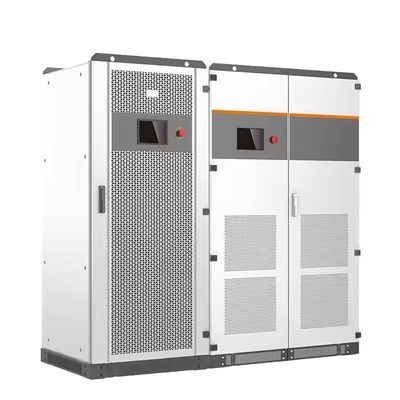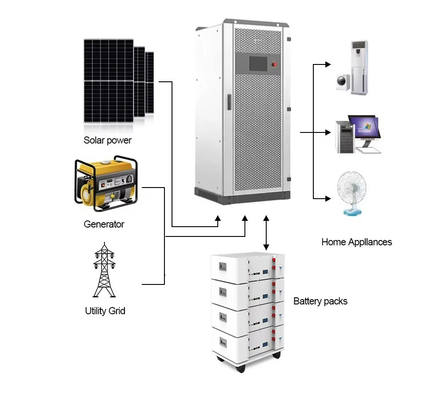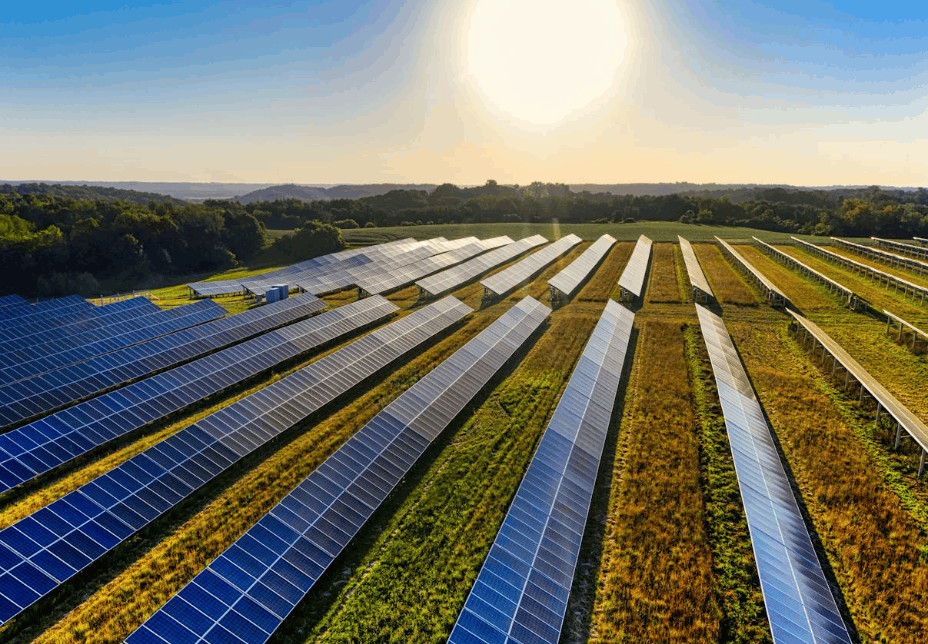100kW 240V High-Leg Delta Hybrid Inverter - Industrial Microgrid Power Solution
Industrial-Grade Power Conversion System
This advanced 100kW hybrid inverter delivers reliable three-phase and split-phase power for large-scale industrial and commercial applications. Featuring a unique 240V high-leg delta configuration with split-phase output, it provides unparalleled flexibility for facilities requiring both three-phase motor drives and 120/240V single-phase loads. With up to four MPPT trackers supporting 240kW PV input and 420-850V battery compatibility, this system represents the cutting edge of industrial power conversion technology.
Key Differentiators from Lower Capacity Models:
-
Enhanced Power Capacity: 100kW continuous (110kVA peak) output for heavy industrial equipment
-
Expanded Solar Input: Up to four independent MPPT channels for complex solar arrays
-
Higher Voltage Battery Support: 420-850V range for modern high-voltage storage systems
-
Advanced Grid Interaction: <20ms transition time between grid-tie and island modes
Technical Specifications
| Category |
Specification |
Technical Notes |
| AC Output |
240V High-Leg Delta + Split Phase |
Provides true three-phase 240V (L1-L2-L3) while deriving 120V (L2-N) |
| Continuous Power |
100kW (110kVA peak) |
110% continuous overload capacity |
| PV Input |
120/180/240kW |
Quad MPPT with 99.9% tracking efficiency |
| Battery Voltage |
420-850VDC |
Supports all major lithium chemistries |
| Dimensions |
1200×800×2050mm |
Forklift pockets for easy installation |
Advanced Technical Features
1. Precision Voltage Conversion
The inverter's patented phase-shifting technology generates clean three-phase 240V power while simultaneously providing 120V single-phase output. This unique capability:
-
Eliminates the need for external transformers
-
Maintains perfect phase balance (±1%)
-
Provides <3% THDi for sensitive equipment
-
Features <20ms transition time between operation modes
*Technical Insight: Utilizes DSP-controlled IGBT modules with 16kHz switching frequency for precise voltage regulation and rapid response to load changes.*
2. Intelligent Solar Harvesting
Our advanced MPPT system ensures maximum energy harvest:
-
Up to four independent tracking channels
-
250-850V operating range
-
1,000V maximum input voltage
-
Cold start capability down to 150V
-
99.9% peak tracking efficiency
Performance Data: Achieves 98.5% conversion efficiency at nominal load with <0.5s MPPT response time to changing irradiance conditions.
3. Industrial Battery Management
The advanced battery interface supports:
-
Multiple lithium chemistries (NMC, LFP)
-
Configurable charge profiles
-
Temperature-compensated charging
-
120/180/240kW charging power
-
State-of-health monitoring
*Safety Feature: Includes integrated DC arc fault detection, ground fault protection, and rapid shutdown capability compliant with NEC 2017/2020.*
Target Applications
Industrial Manufacturing
-
Automotive assembly plants
-
Steel production facilities
-
Heavy machinery operations
-
Industrial process lines
*Case Study: A Midwest manufacturing plant reduced energy costs by 42% after installing this system to power their 24/7 production line while maintaining power quality for sensitive CNC equipment.*
Commercial and Institutional
-
Large retail complexes
-
Hospital campuses
-
University facilities
-
Data centers
Technical Advantage: Parallel operation allows seamless capacity expansion as energy needs grow, with <5ms synchronization between units.
Utility and Energy Infrastructure
-
Microgrid primary power sources
-
Peak shaving applications
-
Renewable integration systems
-
Remote community power
Feature Highlight: Supports advanced grid services including frequency regulation and voltage support with <100ms response time.
System Architecture
Power Conversion
-
Three-level ANPC topology
-
98% peak efficiency
-
<20ms transfer time
-
100% unbalanced load capability
-
200% short-term overload capacity
Control System
-
Dual-core DSP processor with FPGA co-processing
-
Real-time load monitoring and forecasting
-
Predictive maintenance alerts
-
Remote firmware updates
-
Cybersecurity protection
Protection Features
-
Comprehensive overvoltage/undervoltage protection
-
Overfrequency/underfrequency protection
-
Reverse polarity protection
-
Short circuit protection
-
Ground fault monitoring
-
Arc fault detection
Installation Requirements
Electrical
-
400A minimum circuit breaker
-
2/0 AWG copper conductors minimum
-
Proper grounding system (<0.1Ω to earth)
-
Surge protection devices (40kA minimum)
Environmental
-
800mm clearance for ventilation
-
Ambient temperature monitoring
-
Dust filters in high-particulate areas
-
Elevated mounting in flood zones
-
Corrosion protection for coastal installations
Certification & Compliance
This industrial-grade inverter meets or exceeds:
-
UL 1741 SB (Safety)
-
IEEE 1547-2018 (Grid Interconnection)
-
FCC Part 15 Subpart B (EMC)
-
CEI 0-21 (Italian Grid Code)
-
NEC 2020 Rapid Shutdown
-
IEC 62109-1/-2
Note: Certification markings are visible on product label. Always verify current certifications with manufacturer before installation.
Frequently Asked Questions
Performance
Q: What's the efficiency curve across different load levels?
A: Maintains >96% efficiency from 30-100% load thanks to advanced multi-level conversion topology.
Q: How does it handle large motor starting currents?
A: 200% overload capability for 10 seconds handles most industrial motor starts.
Compatibility
Q: What battery management systems are supported?
A: Native support for Tesla, BYD, LG Chem, CATL, Pylontech through CAN/RS485.
Q: Can it work with flow batteries?
A: Yes, with configurable charge profiles for vanadium redox and other flow chemistries.
Installation
Q: What's the recommended maintenance schedule?
A: Semi-annual inspection including thermal imaging, firmware updates, and air filter cleaning.
Q: How many units can operate in parallel?
A: Supports up to 16 units in parallel for 1.6MW systems with centralized control.
Why Choose This Inverter?
-
Industrial Reliability: Military-grade components rated for 100,000+ hours MTBF
-
Future-Proof Design: Software-upgradable for new features and protocols
-
Energy Optimization: Advanced forecasting algorithms maximize self-consumption
-
Reduced Downtime: Hot-swappable components and predictive maintenance
-
Smart Monitoring: Cloud-connected with real-time analytics and alerts
-
Global Compliance: Meets international standards for worldwide deployment

 Your message must be between 20-3,000 characters!
Your message must be between 20-3,000 characters! Please check your E-mail!
Please check your E-mail!  Your message must be between 20-3,000 characters!
Your message must be between 20-3,000 characters! Please check your E-mail!
Please check your E-mail! 










